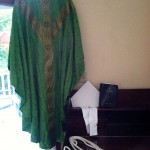Following Tennis, Religiously
 You know those displays, often at museums and fairs, that let you put your head through a hole in a tableau and then suddenly, to people looking at you anyway – the rest of you becomes someone else entirely? The appeal lies in the juxtaposition: we laugh at the world of difference between you and the costume that surrounds you.
You know those displays, often at museums and fairs, that let you put your head through a hole in a tableau and then suddenly, to people looking at you anyway – the rest of you becomes someone else entirely? The appeal lies in the juxtaposition: we laugh at the world of difference between you and the costume that surrounds you.
You’ll never in a million years become Derek Jeter or a maiden in 18th century Sturbridge Village.
Prompted by a couple of different articles about the U.S. Open, I’ve been constructing these tableaux in my mind: Ridiculous as it may be, I put my husband in the space of a tennis player. Now this is a guy with zero interest in tennis; he even has the gall to say it’s “pointless.” So it was a rare moment the other evening when he watched Nadal (whom, I swear, he kind of resembles, or used to resemble) on TV – for a few minutes, anyway, until he got bored. Funny thing is, even though he never goes anywhere near a court with me, I often feel his presence as I play, or when I read about the pros.
Now I’m sure I’m not alone in doing this kind of thing: inserting my own own life into the more famous lives I read about. Teachers talk about how students naturally bring “background knowledge” into the study of literature; this can either go smoothly and add to understanding, or it can be more like putting a head into an opening and seeing how silly the picture can get.
Last Sunday, The New York Times ran a story in the Styles section about the high interest in the wives and girlfriends — dubbed “WAGS”– of professional tennis players. Television cameras these days take us over to these stylish creatures in the stands more than they used to. “There’s something about tennis that may explain fans’ fascination with the romantic companions of their favorite players.” Not surprisingly, we don’t get as many shots of the husbands and boyfriends (they would be “HABS” and thus be confused with Canadian hockey players) of the women players. In both cases, however, glimpsing them is supposed to give more depth to the drama unfolding on the court.
I have to say, I resonate some with these women in their designer glasses. How many times has that camera in church swung over in my direction, catching me just as I’m finding the right hymn, or showing concern about my husband pulling off yet another sermon? I also sympathize with their need to identify themselves as more than just appendages. As one girlfriend in the article put it: “…it’s very important for me to build myself, and I want people to know about me, that I am doing modeling, and that I do something, and I don’t want people to know me because of my boyfriend.” All right then! This is a little gem I’ll put in my bag when I take a break from my own modeling career to go to the New Bishops and Spouses conference later this month.
OK, maybe I’m taking a little liberty with that parallel, but you get the idea. Another article on the same day, this one in the Sports section, also brought my non-tennis playing husband to mind. Entitled “Players’ Superstitions Can Lead to Repetition,” it’s about the high incidence of ritualistic activity among these same pros. Other athletes have their little routines too (my nephew does a great imitation of particular ball players before stepping to the plate) but there’s always been a higher percentage of must-do-things-a-certain-way-or-else behavior in tennis. Some of it, like eating and sleeping properly, doesn’t really count; but what about  Tim Mayotte saying that each day he used to“ eat ¾ pint of chocolate chip ice cream and throw out the rest”? Or Goran Ivanisevic, who had to watch an episode of “Teletubbies” each morning in June 2001 before playing at Wimbledon? According to the article, Nadal “is the king of or routine and ritual. He is well known for carefully positioning his water bottles and drinking from them in a certain order.”
Tim Mayotte saying that each day he used to“ eat ¾ pint of chocolate chip ice cream and throw out the rest”? Or Goran Ivanisevic, who had to watch an episode of “Teletubbies” each morning in June 2001 before playing at Wimbledon? According to the article, Nadal “is the king of or routine and ritual. He is well known for carefully positioning his water bottles and drinking from them in a certain order.”
My husband can also be seen filling and arranging drinking vessels in an ordered and ancient way – although there are a number of significant differences, including the fact that other people will be doing the partaking. Still and all, it was he who reminded me that the words we commonly associate with magic – “hocus pocus” – have their origin in the Latin version of “This is my Body.” Going further, he said that, back in the Middle Ages, there emerged a belief in transubstantiation, whereby the priest’s secret words changed bread and wine into the body and blood of Christ. To its extreme, the bread and wine are no longer thought to be bread and wine at all. It became something akin to sorcery, isolating spiritual power in the hands of the priest alone. In fact, some people still hold, despite the Reformation, to the “magic cookie” theory of the sacraments. My husband, on the other hand, believes that the prayers of the whole congregation engage the Holy Spirit to call forth the living presence of Christ.
said that, back in the Middle Ages, there emerged a belief in transubstantiation, whereby the priest’s secret words changed bread and wine into the body and blood of Christ. To its extreme, the bread and wine are no longer thought to be bread and wine at all. It became something akin to sorcery, isolating spiritual power in the hands of the priest alone. In fact, some people still hold, despite the Reformation, to the “magic cookie” theory of the sacraments. My husband, on the other hand, believes that the prayers of the whole congregation engage the Holy Spirit to call forth the living presence of Christ.
So there I go again, making outlandish comparisons. The fact is, after the Open is over, I’ll just go back to my regular life of hardly at all resembling the women in the stands but maintaining some shred of hope that I myself can hit the ball harder, even as the clock ticks. Unfortunately, there’s nothing whatsoever magic about that.


Polly, you’re right. I never give a flip about what someone’s husband is wearing, but the wife, always the trophy. So hold onto that thought next Sunday, wear that fancy scarf and put the cup back where you found it. Your inquisitive spirit shines through and I enjoyed each of the stories and the way you layered them. Your voice is strong. I can hear you going from thread to thread!
Great, Polly. You have your voice back, and it’s full of life and humor. Maybe it’s the hot pink, flowing clothes that gave your voice room to be flamboyant and fun. Keep it up.
Some of your best writing yet, Polly. Great job weaving together these different threads of your life right now.